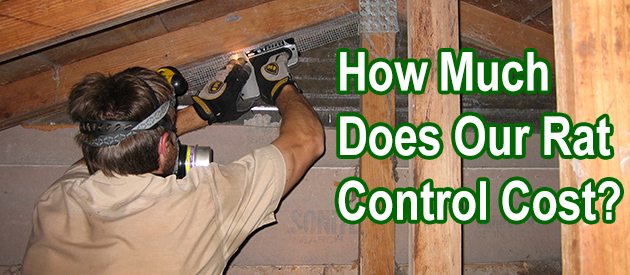Multnomah County, Portland Rat Control Situation:
I have had a serious problem with rats in my house--kitchen, bedrooms, in the walls, etc. I believe they began coming in from the garage which has been filled with junk for years. They ate through parts of my wooden door, through drywall, and even through wood along the sliding glass doors. I have been zapping them with the Rat Zapper, but I keep finding their feces all over and know it is dangerous. I am taking steps to arrange for the garage to be emptied and cleaned and have cleaned out my pantry, cleaned off all the lids, jars, etc, but I still see rat droppings in the living room and in two of the bedrooms. My kids are coming home to stay and I am fearful of disease. Can you clean those areas up and work simultaneously on sealing out entryways? Is it okay to use a dry vacuum to vacuum them up if I spray them well with Clorox first and then throw the vacuum away. I do not have the fancy masks, only the white ones. Is that dangerous. Please let me know what you recommend and costs for your services.
Hello sir. I need your advice. Me and my wife just bought our very first house in north Portland Oregon. My wife is due to give birth and we're to move in to this house by end of this month and there's no turning back since we already gave our landlord notice to move. This house requires some work but I'm emailing you mainly of one thing, rat infestation problem. We just took out an old stove from the kitchen and behind it, we saw about thousand rat droppings on the ground. And the house and detached garage smells. I'm not sure whether it's because house has been abandoned for over a year or what but we need rat problem resolved asap. On your website you mentioned using snap trap is the best way to get rid of rats. Where should I set up the traps? How many should I put? What kind of food should I put on the trap? Any other advice will be greatly appreciated.
Portland Rat Control Tip of The Week
Black Rat Biology
The black rat (Rates Rattus) has likewise been known as a ship rat, rooftop rat, and old English rat, among other names. It is a long-tailed rodent that is native to Asia. However, it is found in practically all parts of the world today. Black rats prefer hotter zones, however, are profoundly versatile, and will look for cover in natural (woods) and unnatural (homes and structures) areas. It is bigger and more aggressive than its brown-colored cousin, but is more vulnerable to cold and has a more constrained diet. Black rats are generally omnivores. They are a genuine threat to ranchers since they will eat a wide scope of farming harvests, seeds, and feed. A large population of black rats can decimate a field of crops, or contaminate a barn full of feed and hay.
A common black rat is 5.02-7.19 in long, including its tail, and weights 4.12 oz. when fully grown. Notwithstanding its name, the black rat is normally not black. Its coat is typically extremely dark brown. In the wild, black rats want to settle in burrows made using the ground litter (leaves, twigs, etc.) found on timberland floors. In urban settings, they like attics and upper floors of structures, making homes from discovered litter, destroyed paper, and insulation.
They are also tasty meals for coyotes, wild dogs, and other predator winged animals. These obtrusive pests are difficult to dispose of once they move in. Talk with your neighborhood experts on approaches to shield your home from being overrun. Keeping your yard free of clutter, yard debris, standing water, and trash will deter them. You should keep all garbage in fixed holders, and pick up outside pet food and feed. Routinely check your home and building for cracks and openings that would give black rats a path to your home. Black rats are keener on living in their normal habitat than in your home; however, they will consistently exploit food, water, and safe shelter.


